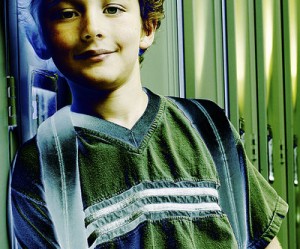INformation Hub
Placement, Short-and-Sweet
Placement, Short-and-Sweet
Current as of August 2017
Once the IEP team has decided what services a child needs, a decision must be made about where services will be provided. Where the child’s IEP is carried out is called placement. Parents have the right to be part of the group that decides the child’s placement.
In deciding the child’s placement, the group must make sure that the child has the maximum opportunity appropriate to learn with children who do not have disabilities—in academic, nonacademic, and extracurricular activities. This part of IDEA is called Least Restrictive Environment or LRE.
Quick-Jump Links
What Does IDEA Require?
 With respect to placement, IDEA has a lot to say. Let’s start with IDEA’s LRE provisions. These are primarily found at §§300.114 through 300.117.
With respect to placement, IDEA has a lot to say. Let’s start with IDEA’s LRE provisions. These are primarily found at §§300.114 through 300.117.
Least Restrictive Environment is explained in IDEA as follows:
. . . To the maximum extent appropriate, children with disabilities . . . are educated with children who are nondisabled; and . . . special classes, separate schooling or other removal of children with disabilities from the regular educational environment occurs only if the nature or severity of the disability is such that education in regular classes with the use of supplementary aids and services cannot be achieved satisfactorily. [§300.114(a)(2)(i)]
IDEA also requires that the child’s placement:
- is determined at least annually;
- is based on the child’s IEP; and
- is as close as possible to the child’s home. [§300.116(b)]
Additional requirements in the law include these:
Unless the IEP requires some other arrangement, the child is educated in the school that he or she would attend if nondisabled. [§300.116(c)]
When looking at placement options, consideration must be given to any potential harmful effect on the child or on the quality of services that he or she needs. [§300.116(d)]
A child with a disability may not be removed from education in age-appropriate regular classrooms just because he or she needs modifications to the general curriculum. [§300.116(e)]
Who Makes the Placement Decision?
Often, the IEP team makes the placement decision. In some places, the placement decision is made by another group of people. In either case, under IDEA, the group that makes the placement decision must include the parent(s) and others who:
- are knowledgeable about the child;
- understand the meaning of his or her evaluation data; and
- know the placement options. [§300.116(a)]
On What is the Placement Decision Based?
When discussing placement, the group should consider the child’s unique needs and determine the least restrictive placement for the child, based upon those needs. A placement that is least restrictive for one child may not be least restrictive for another. What is least restrictive for each child is based on that child’s unique needs. This means that the school system cannot use a “one size fits all” approach to educating children who have a disability. Decisions must be based on individual needs as stated in the IEP, and—
- may not be based on the child’s disabling condition or label (such as placement in a special class for students with intellectual disabilities just because a child has cognitive impairments);
- may not be based on disability program categories (placement in an particular program for students with learning disabilities (LD) just because a child needs LD services); and
- may not be based on the location of staff, on the funds that are available, or on the convenience of the school district. (Rebhorn & Smith, 2008)
What Kind of Placements Are There?
In making placement decisions, the group looks to another important part of the IDEA, the continuum of alternative placements. The continuum includes the different options where children can receive services. These options include placements such as:
- a general education class
- a special education class
- a special education school
- at home, or
- in a hospital or other public or private institution. [§300.115]
How Does the Group Decide Among These Options?
Since its earliest days, IDEA has included a strong preference for children with disabilities to be educated alongside their peers without disabilities, to the maximum extent appropriate. That’s why a student’s placement in the general education classroom is the first option the placement group should consider (71 Fed. Reg. 46588). Can the child be educated satisfactorily in the general education classroom? What aids, services, and supports does the child need to make this possible? If the group decides that the child’s needs can be met in the general education class, with supports, then that placement is the LRE for the child.
What Supports Does the Student Need?
IDEA recognizes that, in many cases, supports must be provided to a child with a disability to enable him or her to be educated in the general education environment, including participating in extracurricular and nonacademic activities and settings. The law calls these supplementary aids and services.
These aids and services often play in a pivotal role in facilitating and supporting the education of individual children with disabilities in the regular educational environment. Supplementary aids and services can be accommodations and modifications to the curriculum under study or the manner in which that content is presented or a child’s progress is measured, but that’s not all they are or can be. Supplementary aids and services can also include direct services and supports to the child, as well as support and training for staff who work with that child. Determining what supplementary aids and services a particular child needs is made on an individual basis.
Here are a few examples that the New Mexico Public Education Department provides online that will give you a sense of the variety and breadth of possibilities:
- Supports to address the environment (e.g., preferential seating for the student; changing the set-up in the room);
- Support or training for staff;
- Planning time for staff;
- Specialized equipment (e.g., wheelchair, computer, software, augmentative communication device, utensils/cups/plates, restroom equipment);
- Pacing of instruction (e.g., breaks, more time, home set of materials);
- How subject matter is provided (e.g., taped lectures, sign language, primary
language, paired reading and writing); - Testing adaptations (e.g., read test to student, modify format, extend time).
For more examples, and a more detailed discussion of these very important supports and services, please read our page dedicated to Supplementary Aids and Services.
Notifying Parents
Although the parents of the child are part of the group determining the child’s placement and are likely to be well informed as to the placement decision, the school system must still provide parents with prior written notice regarding the placement decision a reasonable time before it implements that decision.
And if the Parents Disagree with the Placement Decision?
Should the parents disagree with the placement decision, they have recourse to IDEA’s procedural safeguards, which include mediation and due process procedures, as a way of resolving the conflict. A parent of a child with a disability can also file a state complaint.
Conclusion
In sum, then, determining a child’s placement in the LRE must be done each and every year, basing the placement on the child’s IEP, making the placement as close as possible to the child’s home, and placing the child in the school he or she would normally attend if not disabled (unless, as IDEA states, the child’s IEP requires some other arrangement). These requirements fit within the frame of IDEA’s “strong preference, not a mandate, for educating children with disabilities in regular classes alongside their peers without disabilities” (71 Fed. Reg. 46585).
Special education and related services under IDEA are tightly connected to principles of individualization and are designed to respond appropriately to the needs of each specific child. Those needs drive the IEP that’s developed for the child–which, in turn, drives the placement decision.
——————————————————————————–
References
Assistance to States for the Education of Children with Disabilities and Preschool Grants for Children with Disabilities, Final Rule, 71 Fed. Reg. 46540 (August 14, 2006) (codified at 34 C.F.R. pt.300).
New Mexico Public Education Department. (n.d.). A sampling of supplemental supports aids & services. Retrieved August 16, 2017, from: http://www.ped.state.nm.us/seo/library/qrtrly.0204.lre.handouts.pdf
Rebhorn, T., & Smith, A. (2008, April). LRE decision making (Module 15). Building the legacy: IDEA 2004 training curriculum. Washington, DC: National Dissemination Center for Children with Disabilities.
Back to top
________________________________________
 **Highly Rated Resource! This resource was reviewed by 3-member panels of Parent Center staff working independently from one another to rate the quality, relevance, and usefulness of CPIR resources. This resource was found to be of “High Quality, High Relevance, High Usefulness” to Parent Centers.
**Highly Rated Resource! This resource was reviewed by 3-member panels of Parent Center staff working independently from one another to rate the quality, relevance, and usefulness of CPIR resources. This resource was found to be of “High Quality, High Relevance, High Usefulness” to Parent Centers.
________________________________________
Would you like to keep reading about placement issues?
Placement, Short-and-Sweet (You’re already here!)
Placement, in overview. Here are the basics, if you please.
Considering LRE in Placement Decisions
LRE–least restrictive environment–is a foundational principle in IDEA. What is LRE, and how does it shape placement decisions? This discussion takes a detailed look.
Starter Set of Resources on LRE
Looking for information, resources, and technical assistance to help you and others support children with disabilities in their least restrictive environment in school? Here’s a starter list of places to look online.
School Inclusion
Looking for information about, and best practices for, the inclusion of students with disabilities in regular classrooms and in the daily activities of school?
Placement and School Discipline
How is a child’s placement affected when he or she is being disciplined for a violation of the student code? Find out what authority school personnel have to remove a child from his or her current placement, what authority the hearing officer has, what constitutes a change of placement, and what placement the child will have during any appeal.
SOURCE ARTICLE: Center for Parent Information & Resources
Give us a call at (727) 523-1130 or (800) 825-5736 or request a callback by clicking below.
